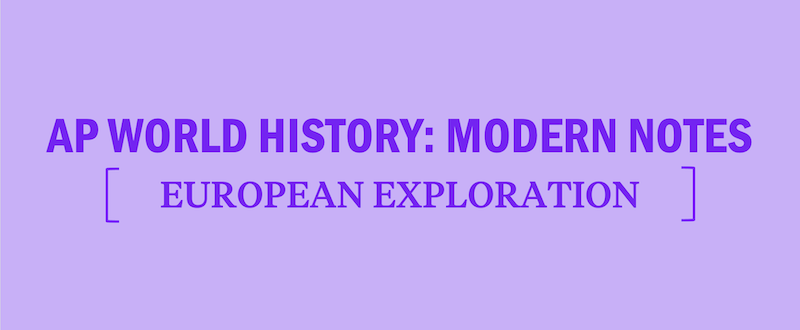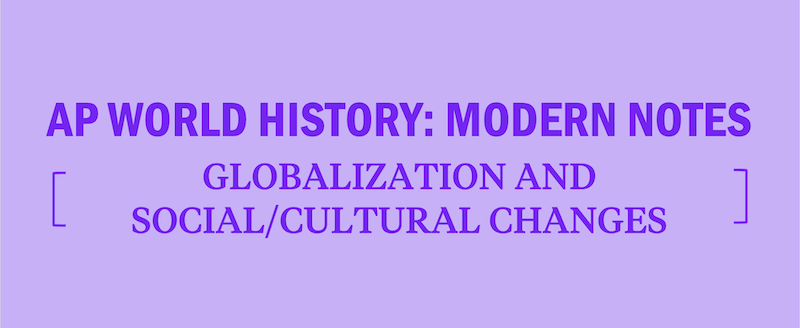Major Events in the Americas: AP World History
Understanding how major events in the Americas affected other civilizations and how civilizations in the Americas were affected by world events is key to success on the AP World History: Modern exam. Read on to learn about major events in the Americas.
Table of Contents:
- Columbian Exchange
- Spanish and Portuguese Colonies in the New World
- Encomienda System
- Latin American Nationalism
- 20th-Century Latin American Political Reform
Columbian Exchange
The inclusion of the Americas in the global trade network led to what would later be called the Columbian exchange: the transfer of plants, food, crops, animals, humans, and diseases between the Old World and the New. The exchange of food crops and animals revolutionized life around the world.
Crops, Livestock, and Disease in the Columbian Exchange
New World crops like the potato had a huge impact on food production and population increases from Ireland to China. In the Americas, entire landscapes were stripped to build plantations that grew cash crops like sugarcane, coffee, and tobacco. These agricultural practices degraded the topsoil and reduced vegetative cover, which led to flooding and mudslides. The introduction of horses to the Americas had a significant impact on some American Indian tribes as they adopted more nomadic lifestyles—for example, some tribes used horses to track and hunt the massive buffalo herds which grazed on the Great Plains. This fostered the development of nomadic societies akin to those of the Eurasian steppe. Meanwhile, the raising of cattle and pigs dramatically changed the landscape. Forests were cut to provide grazing land.
| Old World to New World | New World to Old World |
| Cattle Chickens Cotton Dogs Goats Horses Okra Pigs Rice Sheep Sugarcane Wheat | Avocados Beans Chocolate Maize (Corn) Peanuts Peppers Pineapples Potatoes Rubber Tree Tobacco Tomatoes Vanilla |
However, the Columbian Exchange also led to the spread of disease to the Americas, brought by human carriers, as well as by rats and mosquitoes that Europeans unintentionally brought with them on ships. The introduction of feral pigs to the New World may have contributed to the transmission of diseases in the North American regions initially explored by the Spanish. Smallpox, measles, and other diseases to which the natives of the Americas had no immunity devastated their populations; some estimates of mortality rates for native populations are as high as 90 percent. The loss of life due to disease played a direct role in natives’ inability to fend off European advancement. It also led to the importation of enslaved Africans to work on plantations. Relying on dwindling native populations as a labor force became economically unsustainable, and African slaves were used to meet labor demands.
Mercantilism: The Role and Impact of Silver
Silver, the most abundant American precious metal, was responsible for stimulating the global trade network. Spain controlled the two areas richest in silver production, Mexico and the Potosí mines in the Andes, and made use of large numbers of indigenous forced laborers. The Spanish were driven primarily by the economic theory of mercantilism. The term mercantile system is used to describe the ways in which nation-states enrich themselves by limiting imports and encouraging exports. The goal of mercantilist policies was to achieve a favorable balance of trade that would bring wealth into the country while maintaining domestic employment. The most important objective for mercantilist policies in the sixteenth century was the growth of a nation’s economic power relative to competing nation-states. Spain used silver to trade for silk and porcelain in Asia, as China used the precious metal as a primary medium of exchange and to finance a powerful military and bureaucracy.
The Role and Impact of Sugar
Sugar was another important product at this time. Intensive labor and specialized skills were required for sugar cultivation. Because smallpox had wiped out so many native peoples in the Americas, enslaved Africans became the main labor force. These slaves worked under excessively harsh conditions—mistreatment, extreme heat, and poor nutrition—which led to a significant number of deaths from disease and abuse.
These sugar plantations were, in many aspects, proto-factories, as they were financed and organized to create a single product in a complex process, foreshadowing the organization of mechanized production in the upcoming Industrial Revolution.
Spanish and Portuguese Colonies in the New World
Spanish conquistadors led the way in the conquest of the Americas. The primary Spanish settle- ments, New Spain (Mexico) and New Castile (Peru), were each governed by a viceroy, who reported directly to the Spanish king. In 1494, the Treaty of Tordesillas, an agreement between Spain and Portugal based on an earlier decree by Pope Alexander VI, divided control of any future American territories: the Spanish controlled the land west of the agreed-upon line of demarcation, and the Portuguese controlled the territory east of the line.
Along with its goal of increasing wealth through the creation of an empire, Spain desired to expand the influence of Christianity. Catholic missionaries came to the Americas alongside the conquistadors and built mission churches to convert American Indians, many of whom adopted Christianity but blended it with their indigenous religions. For the most part, however, these Spanish missionaries forcibly imposed European culture on the natives.
The social result of the conquest of this new empire was a multicultural and ethnically mixed population. The peninsulares, the highest social class, came directly from the Iberian peninsula, and their American-born descendants were called Creoles. (Note: Creole also refers to peoples born of both European and Native or West African ancestry.) Those of mixed European and American Indian descent were called mestizos, and those with European and African ancestors were called mulattos. At the bottom of the social order were the American Indians, Africans, and the mixed class of zambos, people of mixed African and Indigenous descent.
Encomienda System
The early Spanish settlers in the Caribbean needed to recruit a great deal of labor. The encomienda system established by the Spanish crown granted colonists the right to demand labor of native peoples in the mines and fields. The laborers were worked hard and punished severely.
Conquistadors like Hernán Cortés and Francisco Pizarro brought this system to the Americas. On the haciendas (large estates), natives were often abused; as a result, Spanish officials replaced the encomienda system with the repartimiento system. Repartimiento compelled native communities to supply labor for Spanish mines and farms as encomienda had, but it limited work time and mandated that wages be paid to native workers. Many communities, however, were required to send large groups of laborers to work on state projects. In Peru, for instance, the labor system called mita mobilized thousands of natives to work in the silver mines. They were paid wages, but there were also many abuses. The mita system had disastrous impacts on the indigenous populations of Peru, as it drained them of able-bodied workers at a time when their communities were experiencing huge population losses due to epidemics of Old World diseases. It also led to indigenous people fleeing their communities to avoid being compelled into service. With fewer workers able to work the fields, agricultural production decreased, leading to famine and malnutrition. The demise of these systems led to the establishment of the Atlantic slave trade and widespread use of slave labor in the Americas.
Latin American Nationalism
By the 1830s, most of Latin America was made up of independent nations, which had been established by revolutions against their respective colonial governments. These new nations faced many problems, such as economies that had been disrupted by many years of warfare and large armies loyal to regional commanders (caudillos) instead of to the new national governments. Additionally, the role of the Catholic Church remained strong. Few questioned its doctrines, but many wanted to limit its role in civil life. In Mexico, for example, politics was a struggle between conservatives and liberals, and instability and financial difficulty made it a target for foreign intervention by the United States and Europe.
20th-Century Latin American Political Reform
Due to gaining national independence in the nineteenth century, and being distinctly in the United States’ area of influence since the beginning of the twentieth century, Latin America’s struggle to develop and modernize was less affected by Europe’s issues than were the colonies and former empires of Eurasia and Africa. After the Second World War, Latin America’s countries began to focus more on internal economic development rather than continue their traditional emphasis on commodity exports.
Growth was slower than in Europe or parts of Asia, and as countries became wealthier, old conflicts arose. Populist or socialist regimes favored more redistribution, while the traditional elites argued for social conservatism, wealth accumulation, and capital reinvestment. Military dictatorships often controlled these conflicts, except in countries like Mexico, Colombia, Venezuela, or Costa Rica, which had achieved a long-term political consensus between the classes and their leaders. Not coincidentally, these countries, along with the continental giant Brazil, also had the highest growth rates and most successful industrial progress. Communism, as promoted by Cuba, challenged many Latin American nations in the 1960s and 1970s, but counterrevolutionary forces supported by the United States prevailed. One example is the U.S.-backed coup that installed Pinochet in power in Chile, ousting the democratically elected socialist government.
In the later decades of the century, regional growth slowed under the impact of high debt incurred during the boom in credit and commodity prices in the 1970s. The world economic crunch in the 1980s led to widespread defaults on loans, negative growth, and instances of hyperinflation in Argentina and Brazil. This, along with the fall of communism, led to a 1990s trend in Latin America toward electoral democracy and neoliberal economics, featuring less regulation, more private investment, the privatization of state enterprises, and freer trade policies. This ideological influence from the United States had mixed results: there were more private enterprise and consumer imports, but also more unemployment and exploitative low-wage jobs.





